Effect of defoliation through leaf pulling on Cabernet Franc
Silvia Liggieri and Corry Craighill
Sunset Hills Vineyards
Summary
The hot humid growing conditions coupled with nutritive soils in Virginia often leads to high vigor canopies. Leaf pulling is highly recommended in humid, cloudy regions like Virginia for the management of disease pressure and shading in the vineyard, however the timing and extent of leaf pulling are a matter of ongoing research. In this study, two post fruitset leaf pulling regimes were tested: 2 leaves on both sides (double) or 3-4 leaves on the East side only (single). Vines treated with leaf pulling on both sides of the vine had higher Brix at harvest, skin phenolics and color intensity. This wine also had significantly higher descriptive scores for color intensity, indicating a difference in radiation led to differences in phenolic development.
Introduction
The hot humid growing conditions coupled with nutritive soils in Virginia often leads to high vigor canopies. High vigor, high density canopies can cause a number of problems in the vineyard and the winery. High vigor canopies often contain inner leaves that do not receive adequate sunlight such that they become carbohydrate sinks rather than sources1. Densely shaded canopies have higher incidence of disease due to poor air flow and poor spray penetration. Shading of developing buds for the following year can lead to fewer inflorescences per shoot2, smaller clusters and reduced berry set1. Shaded fruit can also have higher potassium, pH and TA as well as reduced phenolic compounds, pigments, varietal flavor, and overall sugar accumulation1. Shading can also lead to higher levels of compounds that produce vegetal flavors such as methoxypyrazine and C6 alcohols1,2. By contrast, open canopies in general lead to higher sugar, color, and positive aroma compounds such as nor-isoprenoids (which lead to varietal character in aromatic white wines) and terpenes (which contribute floral, Muscat-like aromas to wine)2.
Leaf pulling is highly recommended in humid, cloudy regions like Virginia for the management of disease pressure and shading in the vineyard3. Though leaves are usually pulled after fruit set, recent studies show early season/prebloom leaf removal can be beneficial for fruit composition and enologically important crop yield parameters including reduced berry size, higher skin to pulp ratio, higher relative berry skin mass, higher grape phenolics, anthocyanins, and color density. Leaf pulling has also been shown to alter the production of carotenoids, precursors to aroma and flavor, by increasing light exposure. Light is thought to trigger both preveraison synthesis of carotenoids as well as post veraison conversion to important fruity aromas4. The drawback of early leaf pulling is the potential for reduced fruit set. However, in some cases, reduced crop yield can be good for leaf area-to-fruit weight ratios, resulting in increased Brix3. In hot humid environments like Virginia, lower fruit set has the effect of reducing cluster compactness, potentially allowing of better radiation exposure (radiation increases phenolics) and better air flow3.
In a recent study examining the effects of the timing and extent of leaf pulling in Cabernet Franc and Petit Verdot, Cain Hickey and Tony Wolf found that post fruit set leaf pulling had little to no effect on crop load while pre-bloom leaf pulling reduced yield by 49-50% over two years. The effects were compounded if repeated in the second year. Aggressive leaf pulling post bloom as well as pre-bloom leaf pulling reduced juice Brix in Petit Verdot but not Cab Franc3. Although leaf removal led to significantly higher cluster exposure and higher berry temperatures, there were no significant differences in total berry anthocyanins or total phenolics in Cabernet Franc. Both pre-veraison carotenoid synthesis and post-veraison degradation were higher in the pre-bloom and high leaf pull treatments4. However, any improvements seen were modest4.
The purpose of this trial was to examine the effect of two post fruitset leaf pulling strategies on grape and wine parameters in Cabernet Franc at Sunset Hills Vineyard. In this experiment, one treatment received leaf pulling of 2 leaves on both sides (double) while the other received 3-4 leaves pulled on the East side of the vine only (single) to determine if one strategy allows better aromatic and/or phenolic development than the other.
Methods
The Cabernet Franc block of the SSV vineyard was divided in half with rows 70-80 receiving post fruitset leaf pulling of 2 leaves on both sides (double) while rows 80-113 received leaf pulling treatment of 3-4 leaves on the East side only (single). At harvest, both treatments were sampled in triplicate. All grapes were harvested and processed into TBins on the same day (9/18). Fruit was destemmed with no crushing. Each TBin received 70 lugs of fruit. Bins were inoculated with 100 g/bin D254 yeast. Bins received two punchdowns and were monitored for Brix and temperature daily. Wine was pressed on the same day, without extended maceration. Malolactic fermentation occurred naturally without inoculation.
Sensory analysis was completed by a panel of 30 wine producers. Wines were presented blind in randomly numbered glasses. Tasters were presented with three wines, two of one type and one of another, and asked to identify which wine was different (a triangle test). There were three tasting groups with the unique wine in the triangle test balanced between groups. Tasters were then asked to score each wine on a scale of 0 to 10 for aromatic intensity, color, fruit intensity, and herbaceous/green character. They were also given open ended questions to describe the wines. Results for the triangle test were analyzed using a one-tailed Z test. Descriptive scores were analyzed using repeated measures ANOVA.
Results
The vines that received leaf pulling on both sides produced grapes with higher Brix at harvest, however these differences were not seen in vineyard sampling (Table 1). There were no differences in pH or TA between treatments (Table 2). There were no significant differences in average cluster weights, berry weights, or berries per cluster (Figures 1&2), indicating differences in leaf pulling did not affect yield components. Both treatments underwent robust fermentation with no notable differences in pace or temperature (Figure 3). Finished wine showed no differences in chemistry with the exception of alcohol, as expected from higher Brix (Table 3). Wines made from vines with leaf pulling on both sides had higher color intensity (Figure 4) and higher levels of anthocyanins (Table 4). These wines also had notably higher levels of quercetin glycosides and tannin (Table 5). Together, these indicate a higher level of sun exposure with leaf pulling on both sides of the vines, leading to increases in skin phenolics.
In a triangle test, 19 out of 30 respondents were able to distinguish which wine was different, indicating the wines were significantly different (Z=3.29, p= 0.0005). There aromatic intensity, fruit intensity, or herbaceous/green character, however, the treatment with leaves pulled on both sides of the vine had significantly higher scores for color (Figure 5), indicating differences in color intensity and anthocyanins were perceptible.
Figure 1: Average cluster weights for three vineyard samples at harvest (in-house data)
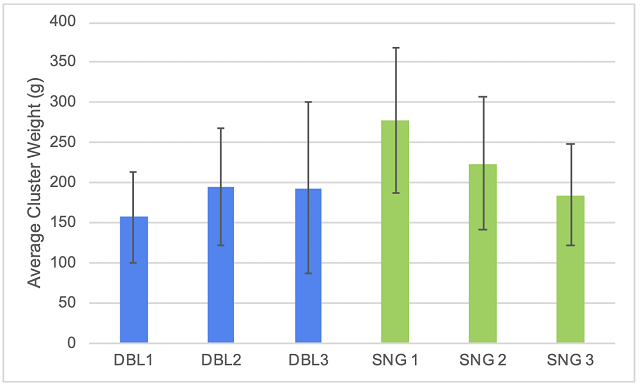
Figure 2: Other fruit metricsfor two treatments of Cabernet Franc (in-house data)

Table 1: Maturity metrics for three vineyard samples at harvest (in-house data)
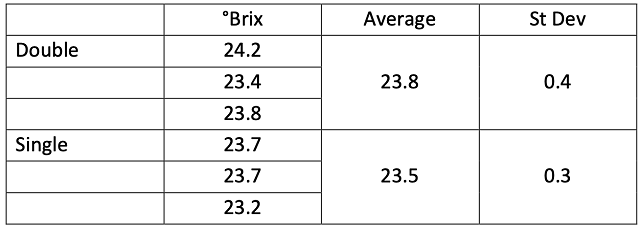
Table 2: Juice chemistry for two treatments of Cabernet Franc (in-house data)

Figure 3: Fermentation kinetics for two treatments of Cabernet Franc (in-house data)
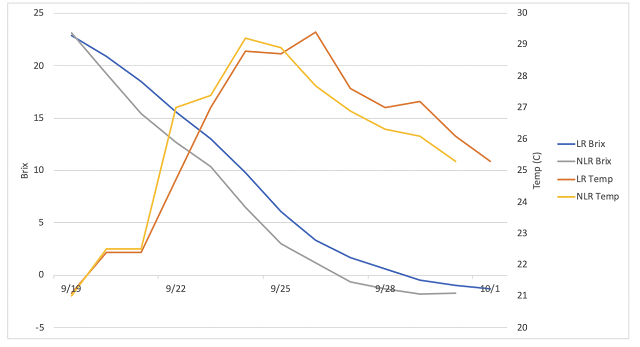
Table 3: Wine Chemistry for two treatments of Cabernet Franc (ICV Labs)

Figure 4: Color Intensity for two treatments of Cabernet Franc (ICV Labs)
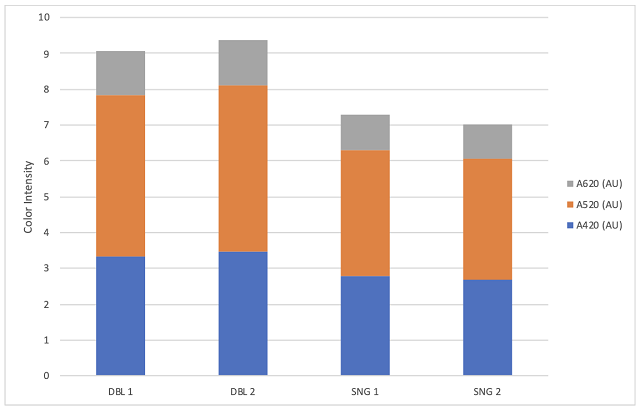
Table 4: Anthocyanins for two treatments of Cabernet Franc (mg/L) (ETS Labs)

Table 5: Phenolics for two treatments of Cabernet Franc (mg/L) (ETS Labs)

Figure 5: Mean descriptive scores for two treatments of Cabernet Franc (WRE)
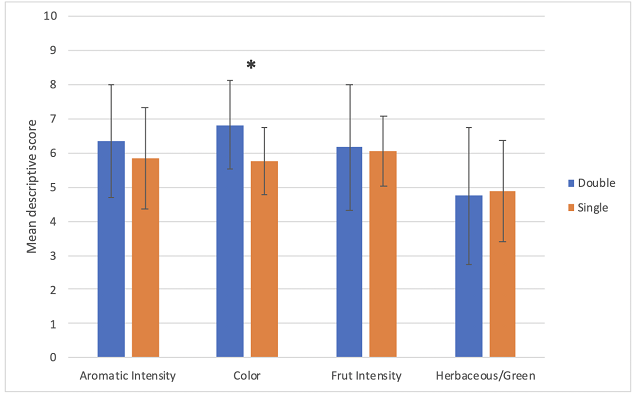
References
(1) Wolf, T. K. Wine Grape Production Guide for Eastern North America; Plant and Life Sciences Publishing: Ithaca, New York, 2008.
(2) Vance, A.; Reeve, A.; Skinkis, P. The Role of Canopy Management in Vine Balance. OSU Extension Catalogue 2013.
(3) Hickey, C. C.; Wolf, T. K. Leaf Removal Effects on Cabernet Franc and Petit Verdot: I. Crop Yield Components and Primary Fruit Composition. Am J Enol Vitic. 2018, 69 (3), 221–230.
(4) Hickey, C. C.; Kwasniewski, M. T.; Wolf, T. K. Leaf Removal Effects on Cabernet Franc and Petit Verdot: II. Grape Carotenoids, Phenolics, and Wine Sensory Analysis. American Journal of Enology and Viticulture 2018, 69 (3), 231–246.
